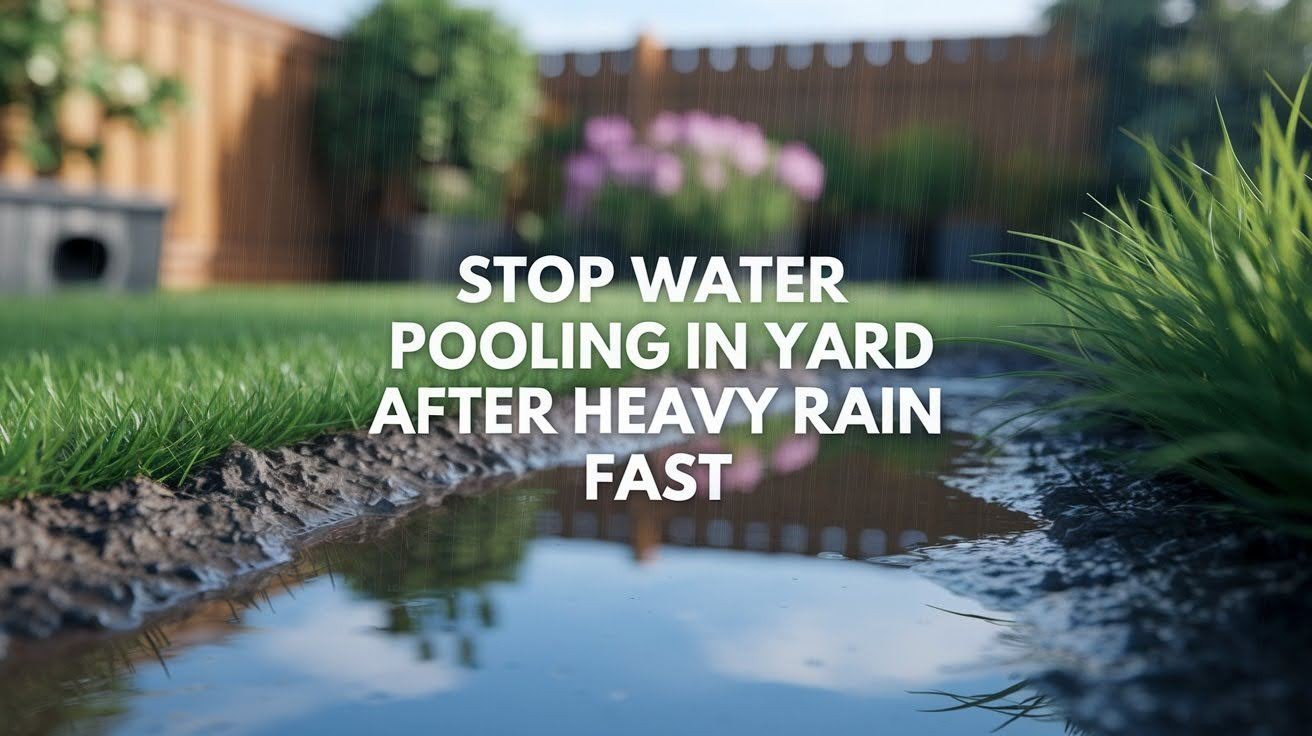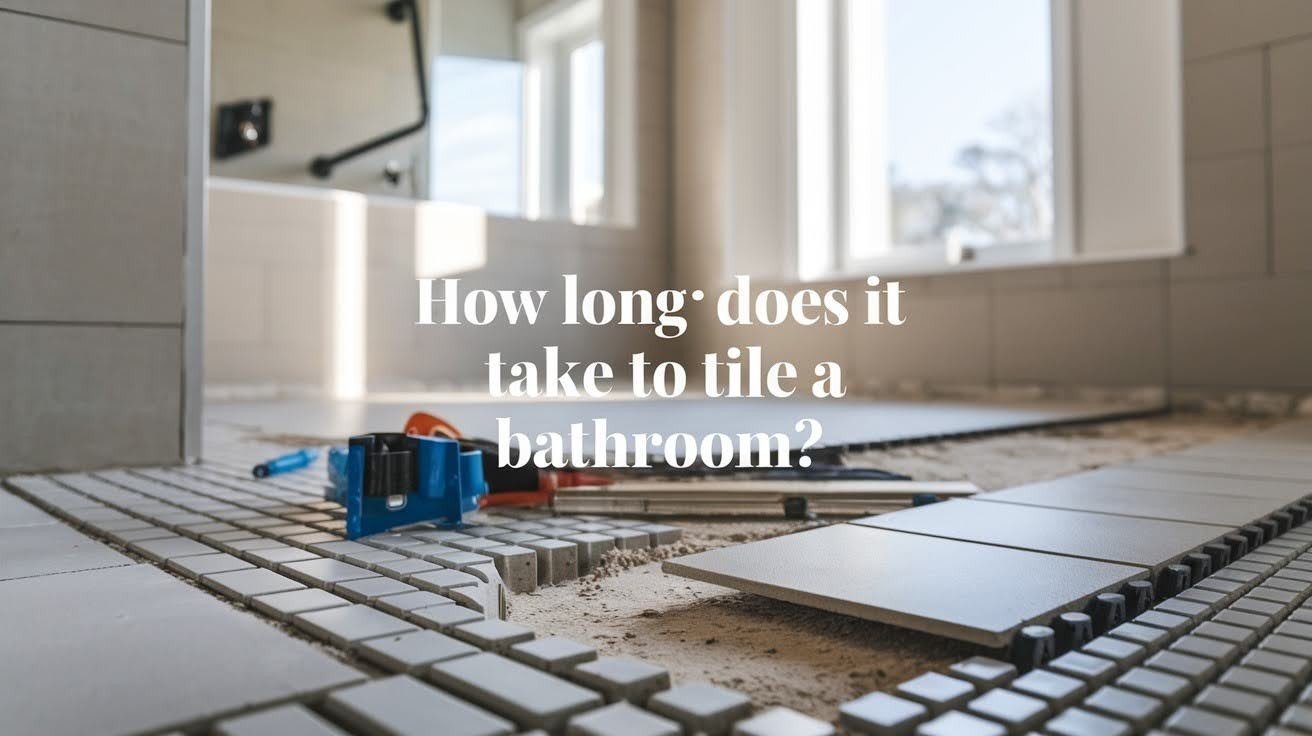You wake up after a storm, and your yard looks more like a swamp than a lawn. This happens to millions of homeowners every year, especially after heavy rain.
As a certified landscape professional with 15 years of experience solving drainage problems, I’ve helped hundreds of homeowners fix standing water issues. Most drainage problems have clear, simple solutions that actually work without huge costs.
This guide covers what causes water pooling, quick fixes you can try today, and professional solutions for serious problems. You’ll learn proven methods based on real-world results from successful drainage projects.
Why Does Water Pool in Your Yard After Rain?
Several common problems cause water to sit in your yard instead of draining away naturally.
Clay Soil and Compaction Problems
Clay soil acts like concrete when it comes to water. Instead of soaking in, the rain sits on top and forms puddles. Heavy construction equipment makes this worse by packing the soil down tight.
You can tell if your soil is too packed by trying to push a screwdriver into the ground after rain. If it won’t go in easily, your soil needs help. Walking on wet clay also makes the problem worse over time.
Grading and Slope Issues
Flat yards become mini lakes because water has nowhere to go. Proper slopes direct water away from your home and toward street drains or other areas where it can soak in safely.
Low spots collect water over time as soil settles or gets washed away. Even small dips in your yard can turn into big puddles during heavy storms.
Drainage System Blockages
Gutters full of leaves and debris can’t handle water from your roof. When gutters overflow, all that water dumps right next to your foundation and creates standing water.
Underground pipes also get clogged with dirt, leaves, and roots. Even small blockages create big problems by backing up water that should flow away from your yard.
Problems Caused by Standing Water
You need to fix drainage problems quickly because standing water causes serious damage to your property and health.
Grass and plants die when their roots sit in water too long. What starts as a small wet spot can kill large sections of your lawn. Dead grass is expensive to replace and makes your home look bad.
Standing water also damages your home’s foundation and creates health risks. Water near your foundation can cause cracks and expensive repairs. Mosquitoes breed in standing water, creating health problems for your family.
Wet areas become slipping hazards and grow mold and mildew. These problems hurt your property value and cost money to fix later.
Quick Fixes You Can Try Today
Start with simple steps to stop more damage and begin fixing small problem areas.
Emergency Steps to Stop More Damage
Turn off your automatic sprinklers right away to stop adding more water to the problem. Clear leaves and debris from gutters and drains so water can flow properly.
Mark problem areas with flags or stakes so you can see exactly where water pools. Create temporary channels with a shovel to direct water away from your house and toward better drainage areas.
Simple DIY Solutions for Small Problem Areas
You can fill shallow low spots with good-quality topsoil to level out your yard. Break up hard soil with a garden fork or rent an aerator to help water soak in better.
Remove thick layers of grass clippings and leaves that block water from reaching the soil. Add compost or other organic matter to clay soil to help it absorb water. Create temporary drainage paths using mulch to guide water where you want it to go.
Professional Solutions for Serious Drainage Problems
Some drainage problems need professional help and specialized equipment to be fixed properly.
French Drain Systems
French drains are gravel-filled trenches with perforated pipes that collect and move water away from problem areas. They work best along the edges of your property or around your foundation.
Installation typically costs $1,000 to $4,000, depending on length and complexity. The work takes 1-3 days and provides long-term results. This solution makes the most sense for ongoing water problems near your house.
Yard Regrading and Slope Correction
Professional grading fixes flat or improperly sloped yards using heavy equipment to reshape the land. Contractors can work around existing trees and landscaping while creating proper water flow patterns.
Major grading projects cost $2,000 to $8,000 but solve drainage problems permanently. The work must be done during dry weather and may require permits in some areas.
Advanced Drainage Options
Dry wells collect and filter runoff in areas where water naturally flows. Rain gardens manage water while adding beauty to your landscape with water-loving plants.
Catch basins handle high-volume water areas like driveways and patios. Retaining walls prevent erosion and flooding on sloped properties. These solutions cost more but provide complete drainage control.
How to Prevent Water Pooling Problems?
Keeping water from pooling in your yard is easier when you take small, simple steps regularly.
- I make it a habit to clean my gutters and downspouts each season so water flows freely.
- I check my yard drains often and remove any blockages I find to avoid surprises.
- Each year, I test my soil and add compost or amendments to keep it healthy.
- I water my lawn deeply but less often to help roots grow strong and prevent puddles.
- I adjust sprinklers and use rain sensors so my garden only gets the water it really needs.
Best Plants for Areas with Drainage Issues
You can choose plants that help solve drainage problems instead of making them worse.
Water-loving perennials like astilbe, cardinal flower, and swamp milkweed soak up excess moisture while looking great. These plants thrive in wet soil and reduce standing water naturally.
Native grasses with deep root systems improve soil structure and absorb lots of water. Buffalo grass, switchgrass, and blue grama are good choices that also require less maintenance than regular lawn grass.
Avoid shallow-rooted plants and those that need dry soil in wet areas of your yard. Plants like lavender, rosemary, and most herbs will die in soggy conditions and won’t help your drainage problem.
When Professional Help Is Necessary?
Some drainage problems are too complex or dangerous to handle yourself and require expert help.
Water entering your basement or foundation needs immediate professional attention to prevent structural damage. Large areas needing major slope corrections require heavy equipment and expertise you can’t get with DIY methods.
Foundation cracks or signs of structural damage mean the problem has gone beyond simple drainage fixes. Complex drainage systems often require permits and must meet local building codes.
If drainage problems affect multiple properties or involve septic systems, you need professional assessment and solutions. These situations involve legal and safety issues that require expert handling.
How to do it?
Follow this plan to solve your drainage problems efficiently and cost-effectively.
Start with simple, low-cost solutions like clearing drains and fixing obvious blockages. Take photos of problem areas during and after rain to document issues for contractors or insurance purposes.
Get multiple quotes for professional work and plan major projects during dry seasons when contractors can work efficiently. Set realistic timeline and budget expectations based on your specific situation.
Focus on preventing problems before the next storm season arrives. Regular maintenance costs much less than emergency repairs and major reconstruction projects.
Conclusion
Standing water problems are fixable when you use proven methods. I’ve seen thousands of successful drainage repairs using these techniques. Start with simple fixes first, then move to professional solutions only if needed.
Don’t wait until the next storm damages your property. Regular maintenance prevents most water pooling issues and saves you money long-term. These methods have worked for homeowners across different climates and soil types.
Take action this weekend by checking your gutters and marking problem areas. Your property and wallet will benefit from addressing drainage issues now.
Frequently Asked Questions
How Long Should Water Stay in My Yard After Heavy Rain?
Normal drainage clears most water within 2-6 hours. Clay soil takes longer than sandy soil. Water standing after 24 hours indicates drainage problems needing attention.
Can I Fix Drainage Problems During Winter Months?
Spring and fall work best for major projects. Winter allows planning and emergency repairs only. Clear frozen drains and prepare materials for spring installation.
Will Adding Sand to Clay Soil Help with Drainage?
Sand mixed with clay creates concrete-like conditions, worsening drainage. Use compost, aged manure, or perlite instead. Always test the soil before adding amendments.
How Much Does Professional Drainage Work Cost?
French drains cost $10-20 per foot. Regrading ranges $2,000-8,000. Costs vary by soil type, equipment access, and permits needed. Get multiple estimates.
Do Drainage Problems Affect My Home Insurance?
Standard policies don’t cover poor drainage damage. Document improvements with photos and receipts. Some companies offer discounts for proven flood prevention measures.






